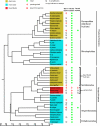Genomic and genetic evidence for the loss of umami taste in bats
- PMID: 22117084
- PMCID: PMC3318850
- DOI: 10.1093/gbe/evr126
Genomic and genetic evidence for the loss of umami taste in bats
Abstract
Umami taste is responsible for sensing monosodium glutamate, nucleotide enhancers, and other amino acids that are appetitive to vertebrates and is one of the five basic tastes that also include sour, salty, sweet, and bitter. To study how ecological factors, especially diets, impact the evolution of the umami taste, we examined the umami taste receptor gene Tas1r1 in a phylogenetically diverse group of bats including fruit eaters, insect eaters, and blood feeders. We found that Tas1r1 is absent, unamplifiable, or pseudogenized in each of the 31 species examined, including the genome sequences of two species, suggesting the loss of the umami taste in most, if not all, bats regardless of their food preferences. Most strikingly, vampire bats have also lost the sweet taste receptor gene Tas1r2 and the gene required for both umami and sweet tastes (Tas1r3), being the first known mammalian group to lack two of the five tastes. The puzzling absence of the umami taste in bats calls for a better understanding of the roles that this taste plays in the daily life of vertebrates.
Figures


References
-
- Altringham JD. Bats: biology and behavior. Oxford: Oxford University Press; 1996.
-
- Bahlman JW, Kelt DA. Use of olfaction during prey location by the common vampire bat. Biotropica. 2006;39:147–149.
-
- Behrens M, Meyerhof W. Gustatory and extragustatory functions of mammalian taste receptors. Physiol Behav. 2011;105:4–13. - PubMed
-
- Damak S, et al. Detection of sweet and umami taste in the absence of taste receptor T1r3. Science. 2003;301:850–853. - PubMed
-
- Fenton MB. Bats. New York: Facts on File; 1992.
Publication types
MeSH terms
Substances
LinkOut - more resources
Full Text Sources

